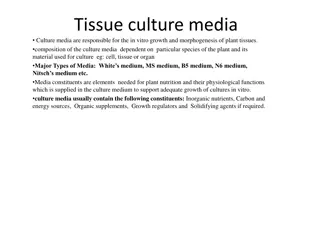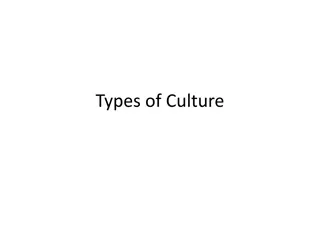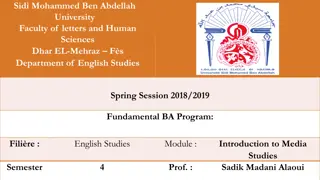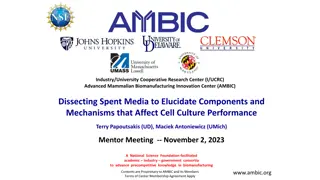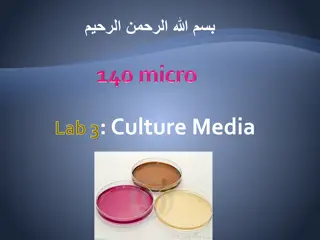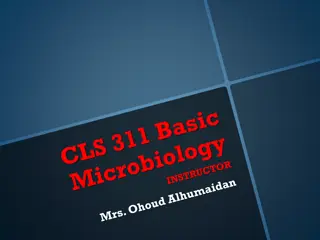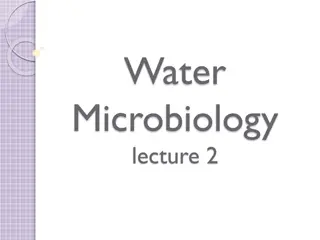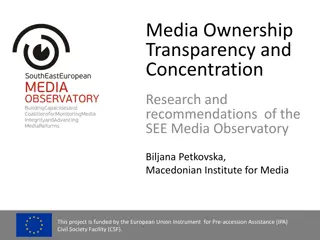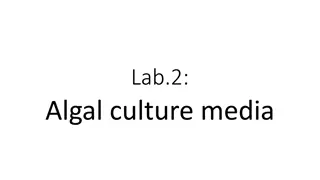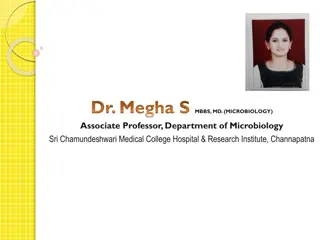Culture Media in Microbiology
Culture media play a crucial role in studying microorganisms and their growth. They can be liquid, semi-solid, or solid, providing essential nutrients for bacterial development. Simple media offer basic nutrition, while complex media contain additional ingredients to support specific bacterial properties. Enriched media like Blood Agar and Chocolate Agar promote the growth of particular bacteria. Different types of media, such as MacConkey agar, serve diverse purposes in microbiological studies by stimulating bacterial growth or inhibiting competitors. These media are vital tools in microbiology research.
Download Presentation

Please find below an Image/Link to download the presentation.
The content on the website is provided AS IS for your information and personal use only. It may not be sold, licensed, or shared on other websites without obtaining consent from the author.If you encounter any issues during the download, it is possible that the publisher has removed the file from their server.
You are allowed to download the files provided on this website for personal or commercial use, subject to the condition that they are used lawfully. All files are the property of their respective owners.
The content on the website is provided AS IS for your information and personal use only. It may not be sold, licensed, or shared on other websites without obtaining consent from the author.
E N D
Presentation Transcript
By Dr. Hesnaa Saeed Al-Mossawi
Culture cultivated in the lab for the purpose of studying them. Medium ingredients that will support the growth The ability of microorganism to use a particular compounds is dependent upon the genetic makeup (DNA) that the cells have. Culture media may be found in one of three states: liquid (called broth) semi-solid solid. Culture is the term given to microorganisms that are Medium is the term given to the combination of
Simple or basal media are culture media which contain the minimum adequate nutrition for non fastidious organisms Uses:- This is basis of most of the media used in the study at common pathogenic bacteria. It is used for subcultures of certain organisms. 1. 2. NUTRIENTAGAR NUTRIENTbroth
Complex media have added ingredients for bringing out certain properties or providing special nutrients required for growth of the bacterium When basal medium is added with some nutrients such as blood, serum or egg is called enriched media. They are used to grow bacteria which are more exacting in their nutritional needs.
BLOOD AGAR TYPE : Enriched media. APPEARANCE : Red color. COMPOSITION : Nutrient agar + Defibrinated sheep blood USES : Routine culture It is also an indicator medium showing the haemolytic properties of bacteria CHOCOLATE AGAR Also called Heated blood agar. TYPE : Enriched media. APPEARANCE : Chocolate brown PROCEDURE : Melt the desired amount of nutrient agar. Cool it in a water bath at 75 C . Add 10 ml of sterile blood . Mixing the blood and agar by gentle agitation from time to time until the blood become chocolate brown in color USES : CHOCOLATE AGAR Enriched media. Chocolate brown color. color.
In this media, it has a stimulating effect on the bacteria to be grown or inhibits its competitors. This result in an absolute increase in the number of wanted bacteria related to other bacteria. Example:- Selenite F broth It is enrichment medium for culture of Salmonella typhi and paratyphi bacilli from stool sample MacConkey agar is a culture medium designed to grow Gram-negative bacteria. It is a useful medium for the cultivation of Enterobacteriaceae MacConkey agar showing both lactose and non-lactose fermenting colonies. Lactose fermenting colonies are pink whereas non-lactose fermenting ones are colourless.
is an microbiological growth medium that is commonly used for antibiotic susceptibility testing. Originally formulated for isolation of Neisseria species. It is also used to isolate and maintain Neisseria and Moraxella species.






